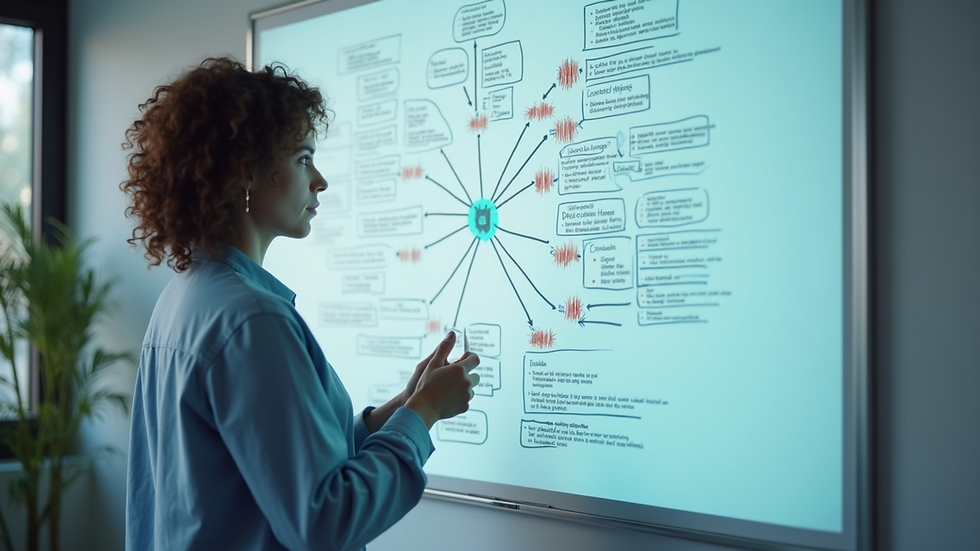Enhancing Collaborative Learning with AI Tools
- NexTeach 360

- Aug 12
- 4 min read
In today’s fast-paced educational world, technology is reshaping how students and teachers interact. One of the most exciting developments is the rise of AI-enhanced group learning. This approach combines the power of artificial intelligence with the natural benefits of working together. It’s transforming classrooms into dynamic spaces where students collaborate more effectively, and teachers can tailor their support like never before.
Let’s dive into how AI tools are boosting group learning experiences, making education more engaging, efficient, and personalized.
The Power of AI-Enhanced Group Learning
AI-enhanced group learning is not just a buzzword. It’s a practical way to improve how students work together. AI tools can analyze group dynamics, track progress, and suggest resources in real-time. This means groups can stay on task, understand each other better, and learn more deeply.
For example, AI-powered platforms can monitor which students are contributing and who might need extra help. They can recommend personalized activities or even adjust the difficulty level of tasks based on the group’s performance. This keeps everyone engaged and challenged appropriately.
Teachers benefit too. Instead of spending hours grading or managing group conflicts, AI tools provide insights and alerts. This frees up time to focus on guiding students and fostering creativity.
Here are some key benefits of AI-enhanced group learning:
Real-time feedback: Students get instant suggestions to improve their work.
Personalized learning paths: AI adapts tasks to fit each student’s needs.
Improved communication: Tools help clarify ideas and encourage participation.
Efficient assessment: Teachers receive detailed reports on group progress.

How AI Tools Facilitate Better Group Interaction
One of the biggest challenges in group learning is ensuring everyone participates and understands the material. AI tools tackle this by creating a more inclusive environment.
For instance, AI chatbots can moderate discussions, prompting quieter students to share their thoughts. Speech-to-text features help students who struggle with writing to contribute verbally. Meanwhile, AI-driven translation tools break down language barriers in diverse classrooms.
Another exciting feature is AI’s ability to analyze communication patterns. It can detect if a group is stuck on a problem or if one member is dominating the conversation. The system then suggests strategies to balance participation and keep the group moving forward.
Some AI platforms also offer virtual whiteboards and brainstorming tools that capture ideas visually. This helps students organize their thoughts and collaborate creatively, even when working remotely.
Teachers can use dashboards to monitor group health and intervene early if needed. This proactive approach prevents frustration and keeps learning on track.

What is meant by collaborative learning?
Collaborative learning is a teaching approach where students work together to solve problems, complete tasks, or understand new concepts. It emphasizes teamwork, communication, and shared responsibility. Unlike traditional learning, where students work individually, collaborative learning encourages interaction and mutual support.
When combined with AI, this approach becomes even more powerful. AI tools provide structure and support, helping groups stay organized and focused. They also offer personalized feedback, which enhances each student’s contribution.
For example, in a science project, students might use AI to gather data, analyze results, and create presentations. The AI can suggest resources, check for errors, and help divide tasks based on each member’s strengths.
This blend of human collaboration and AI assistance leads to deeper understanding and better retention of knowledge.

Practical Tips for Integrating AI in Group Learning
If you’re ready to bring AI-enhanced group learning into your classroom, here are some actionable steps to get started:
Choose the right AI tools: Look for platforms that are user-friendly, secure, and designed for education. Prioritize tools that offer real-time collaboration features.
Set clear goals: Define what you want your students to achieve through group work. Use AI to track progress toward these goals.
Train students and staff: Provide training sessions to help everyone understand how to use AI tools effectively.
Encourage balanced participation: Use AI insights to ensure all students contribute equally.
Integrate AI with existing curricula: Align AI activities with your lesson plans to reinforce learning objectives.
Monitor and adjust: Regularly review AI-generated reports and adjust group tasks or support as needed.
By following these steps, you can create a supportive environment where technology enhances human interaction rather than replacing it.
Looking Ahead: The Future of AI in Education
The potential of AI-enhanced group learning is vast. As AI technology evolves, we can expect even more sophisticated tools that understand emotions, adapt to learning styles, and foster creativity.
Imagine AI tutors that join group discussions, offering hints and encouragement without taking over. Or platforms that simulate real-world problems, allowing students to collaborate on solutions in virtual environments.
Privacy and ethical use of AI will remain top priorities. Platforms like Nexteach 360 are committed to protecting student data while delivering powerful educational tools.
By embracing AI-enhanced group learning, schools can prepare students for a future where collaboration and technology go hand in hand.
If you want to explore more about how technology is transforming education, check out this insightful article on collaborative learning.
Together, we can create classrooms that inspire, engage, and empower every learner.




Comments